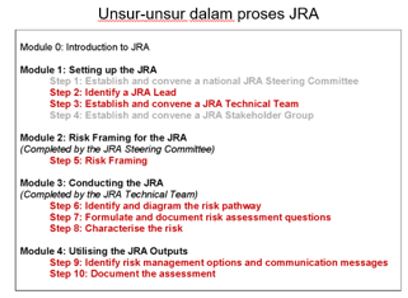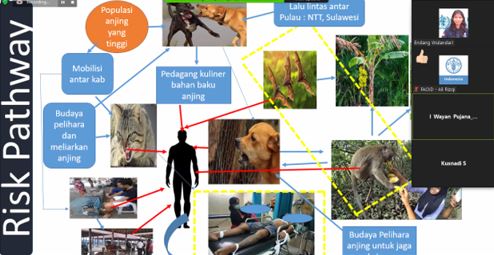
WHO-FAO-OIE supported the Ministry of Health in collaboration with the Ministry of Agriculture and Ministry of Environmental and Forestry to conduct a joint risk assessment training programme. (Credit: Endang Wulandari/WHO)
Around 60% of emerging infectious diseases that are reported globally are zoonotic diseases, or diseases transmitted from animals to humans, such as rabies, avian influenza and salmonellosis. Zoonotic diseases continue to be a threat to public health while also causing economic losses. A multisectoral, One Health approach is critical to address complex health threats at the human-animal-environment interface.
WHO, Food and Agriculture Organization (FAO) and World Organisation for Animal Health (OIE) have developed a Joint Risk Assessment Tool as a guide to address zoonotic diseases. The tripartite collaboration supported the MoH, the Ministry of Agriculture (MoA) and the Ministry of Environment and Forestry (MoEF) to conduct a joint risk assessment (JRA) training involving 75 participants from human, animal and wild life sectors from both national and sub-national levels. Provincial health officers, provincial animal health officers and staff from Conservation of Natural Resources Offices attended the training programme.

WHO, FAO and OIE facilitated a group discussion on risk pathways as part of the joint risk assessment training. Credit: Endang Wulandari/WHO
The JRA is a qualitative systematic approach of gathering, assessing, and documenting information to estimate the risk level for a specific time period and location which focuses on risks at the human-animal-wildlife interface. It is an iterative process based on the best information available during the assessment. The JRA operational tool was designed to support countries in applying a consistent and harmonised approach to assessing risks posed by zoonotic disease hazards. The quality of the assessment would greatly rely on the data and expertise contributed by relevant sectors, this may include epidemiological data, animal migration, and environmental data.
Three batches of five-day JRA training sessions were conducted between 30 November and 18 December 2020. Each training session covered setting up the JRA, forming of steering committee and technical team, and steps to conduct the JRA. These steps include: developing risk framing to define hazard, scope and objectives; developing a risk pathway diagram to outline the risk factors and risk pathways of infection transmission; formulating risk questions; risk characterization using a risk matrix by estimating likelihood, impact and uncertainty; formulating risk management options and risk communication messages, identifying crucial information gaps; and documenting the JRA.
The participants actively engaged during the combination of lectures and group discussions. The exercises during the group work discussed JRA of nipah virus in North Sumatra; rabies in West Kalimantan, Nusa Tenggara and Bali; leptospirosis in Central Java, anthrax in Yogyakarta, East Java and Sulawesi; influenza A HxNy in North Sulawesi; and Avian Influenza H5N1 in Pangkal Pinang, Bangka Belitung. The participants used available data from human, animal and wild life sectors as well as other data available from multiple sectors to conduct the JRA exercise.
The results of the JRA were useful to understand the extent of zoonosis risk within specific areas, provide evidence-based policy options on communication and budget allocation for zoonosis control, and improve zoonosis planning and preparedness capacity as part of health security and zoonosis risk mitigation. As a way forward, MoH will roll out the JRA at the subnational level.
